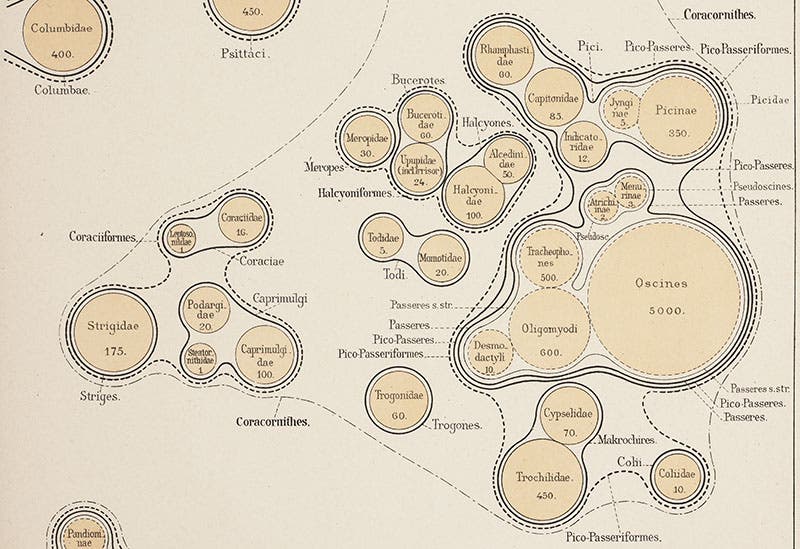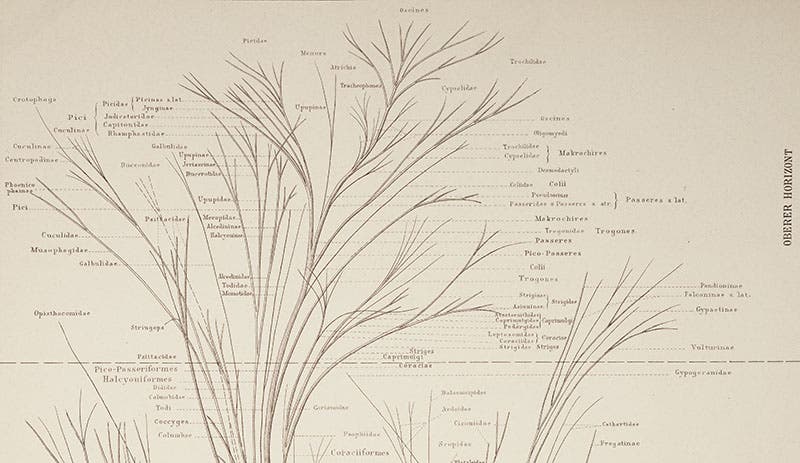Scientist of the Day - Max Fürbringer
Max Fürbringer, a German animal anatomist and taxonomist, was born Jan. 30, 1846. In 1888, Furbringer published his Untersuchungen zur Morphologie und Systematik der Vögel (Investigations on the Morphology and Systematics of Birds), two very fat folio volumes crammed with information about bird anatomy and classification. There are 31 plates at the end of volume 2, all of which introduce novelties into scientific illustration, but we are going to limit ourselves to the last five, which attempt to provide, pictorially, an evolutionary taxonomy of the class of birds. The first two of these five plates each show an evolutionary tree (first image). It had been only 14 years since Ernst Haeckel gave us the first true evolutionary tree, which you can see in the first two images of our Scientist of the Day entry on Haeckel two years ago. Haeckel confined all the birds (Vögel) to a single twig on his tree. Compare that to Fürbringer's tree of just the birds. The twig has grown into an enormous shrub that is both incredibly complex and graphically beautiful. Fürbringer actually illustrated his tree twice, once from the front (plate 27) and again from the back (plate 28, the one we reproduce here) - otherwise some of the details of branching would have been obscured.
The real novelty of Fürbringer’s pictorial taxonomy came in plates 29a, 29b, and 30, where he took cross-sections of his tree in early, middle, and late avian history (no real dates were known at the time). We show here the section made halfway up the tree (second image), and the section made about 3/4 the way up (third image).
This is a very unusual, but highly effective way to diagram the divergence of bird species over time. In the sections, the larger circles indicate families with more species, and the distances apart indicate evolutionary distance.
In a detail of the top section (fourth image), the largest circle contains the Oscines (the family of songbirds), which is surrounded by Halcyones (kingfishers), Trochilidae (humingbirds), and Picinae (woodpeckers), and many others. Strigidae (owls) are offset to the left, while the Falconidae (falcons) are consigned to the bottom, and the Columbidae (pigeons and doves), Psittacidae (parrots) and Cuculidae (cuckoos) are isolated at the top.
We also show a detail of the top of the evolutionary tree, the region where the last section was made (fifth image). Not being experts in bird systematics ourselves, we will let the graphics speak for themselves.
We will note that Fürbringer took courses from Haeckel at the University of Jena and admired Haeckel greatly. Sometimes the tree doesn’t fall very far from the tree.
Dr. William B. Ashworth, Jr., Consultant for the History of Science, Linda Hall Library and Associate Professor, Department of History, University of Missouri-Kansas City. Comments or corrections are welcome; please direct to ashworthw@umkc.edu.










